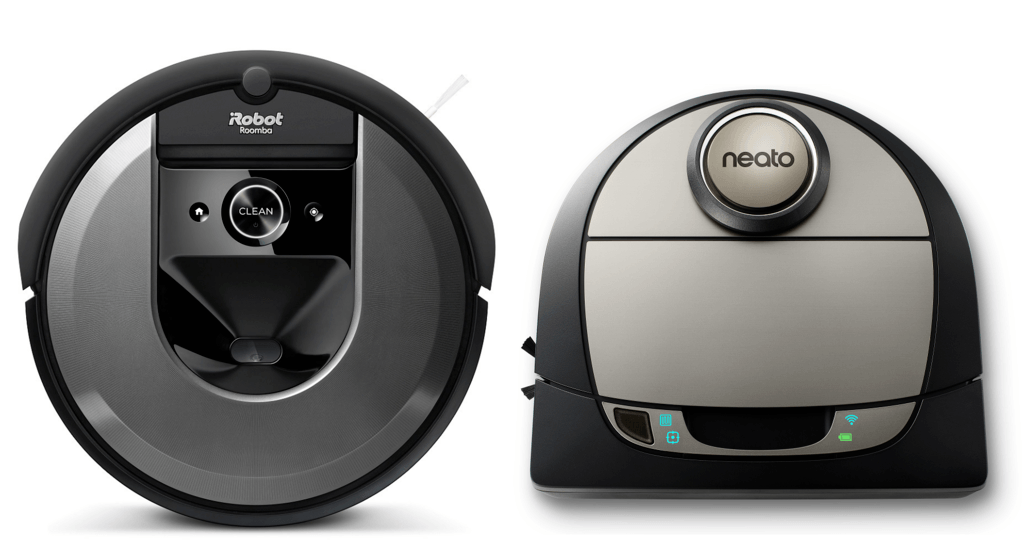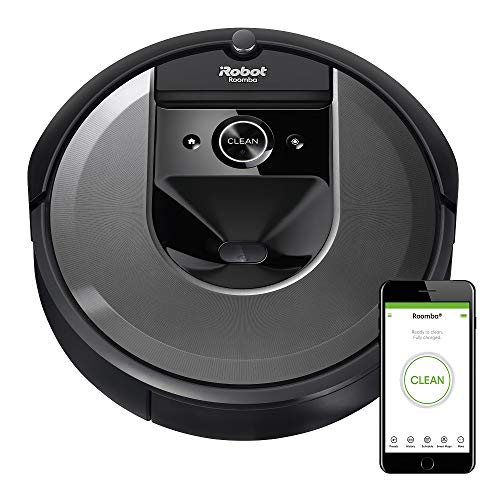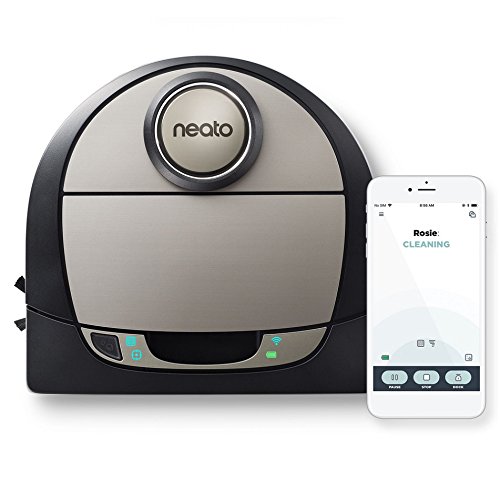Neato and Roomba have been battling for the crown of best robotic vacuum since Neato came to town. When the BotVac D7 Connected was introduced, it held its own against the mighty Roomba 980. While most consider that it fell short, eyes moved to the Roomba i7. Could this be the end-all-be-all of robotic vacuums? Not quite. Though it is closer.
Neato fans still claim that the newest Roomba model is no match for the D7, especially when it comes to navigation, containment and cleaning power on carpet.
This article will compare the Roomba i7 against the Neato D7 to find out if a new king can be crowned.
If your final decision is down to these two models, this is the review for you. In my opinion, the i7 still reigns.
Contents
Differences between Roomba i7 and Neato D7
Not all robots are created equal. These two have a few notable differences and they are outlined for you right here:
- The Neato D7 uses laser-guided navigation technology where the Roomba i7 uses a camera-based navigation
- The motor has two speeds in the BotVac D7 where the i7 has a single, constant speed.
- You can alter the mapping of your home through the app with the Roomba model; the Neato model doesn’t allow mapping changes.
- The Roomba i7 uses dual brushless extractors where the Neato has a combination roller that uses bristles and rubber paddles.
- The most obvious difference is the shape; The Roomba has a round design where the Neato is a D-shape.
Similarities between Roomba i7 and Neato D7
While they certainly have their differences, the i7 and D7 also share some important aspects in common. These include:
- Both models use a large lithium-ion battery pack to provide up to 120 minutes of clean time.
- Each device will automatically return to the charging dock when the battery is low, then resume cleaning (if needed) once the battery is charged.
- You can use physical barriers or digital barriers for containment with both the Roomba i7 and the Neato D7.
- Both of the units utilize mobile apps for controls, scheduling and programming.
- You will find an extra large collection bin (0.7L) on both models.
- Each comes with a HEPA-style efficiency filter.
- Both the Roomba and Neato are rated for all floor types.
Specifications Chart
Let’s take a quick look at the two devices side by side to determine precisely what they do and do not offer.
| Neato BotVac D7 Connected | Roomba i7+ | |
| Size | 12.5×13.2×3.9 inches | 13.34×13.34×3.63 |
| Weight | 7.5 pounds | 7.44 pounds |
| Navigation | Laser Smart vSLAM | iAdapt 3.0 |
| Battery | 3300mAh lithium-ion | 3600mAh lithium-ion |
| Runtime | Up to 120 minutes | Up to 120 minutes |
| Charge Time | 4 hours | 3 hours |
| Automatic Recharge | Yes | Yes |
| Entire Level Clean | Yes | Yes |
| Filter | HEPA | High-efficiency |
| Carpet Boost | Fixed mount, dual speed motor | Adjustable position, single speed motor |
| Drop Sensors | Yes | Yes |
| Bump Sensors | Yes | Yes |
| Dirt Detection Sensors | No | Yes |
| Camera Navigation | No | Yes |
| Laser navigation | Yes | No |
| Wireless Communications | Yes | Yes |
| Mobile App | Yes | Yes |
| Voice Controls | Yes | Yes |
| Floor Types | All | All |
| Imprint Smart Mapping | No | Yes |
| Collection Bin Capacity | 0.7L | 0.7L |
| Washable Collection Bin | No | Optional (separate purchase) |
| Automatic Collection Bin Emptying | No | Optional (separate purchase) |
| Side Brushes | 1 Side Brush | 1 Side Brush |
| Containment | Digital No-Go Lines, Boundary Tape | Dual Mode Virtual Wall Barrier, Digital Room Selection |
| Warranty | 1 year | 1 year |
| Price | Check on Amazon | Check on Amazon |
Comparing the Neato D7 and Roomba i7 in Detail
Let’s get on with the show! We will dive in and take a look at what matters most to you about these two machines. Ready? Read on.
Both Robots are Rated for All Floor Types, but Will They Perform?
The Roomba 980 was arguably the best floor cleaning robot to date. It was one of the only models on the market that would easily handle all carpet styles, including high pile and shag. The Roomba i7 takes a small step back in this regard and the Neato D7 takes an upgraded step forward.
Unlike the 980, the Roomba i7 doesn’t have a dual-speed motor. It is designed to be an all-inclusive floor cleaner, where the 980 was more designed for all carpeting. What does this mean? It means there is no longer carpet-boost, per se.
It is still there; you just don’t notice it. The machine won’t rev up or produce more suction power. However, it is a lot quieter and produces an overall suction power greater than the predecessor. iRobot also adjusted the motor’s location within the robot. This gives a more streamlined suction path and helps clan all carpets.
The Roomba will clean high pile carpeting and some lower pile shags, but not as effectively. What it will do, though, is note when the area isn’t exactly clean and return to make multiple passes. So while all of your spilled flour may not be scooped up on the first pass, the machine won’t let it sit forever.
Both Machines get a Boost on Carpet
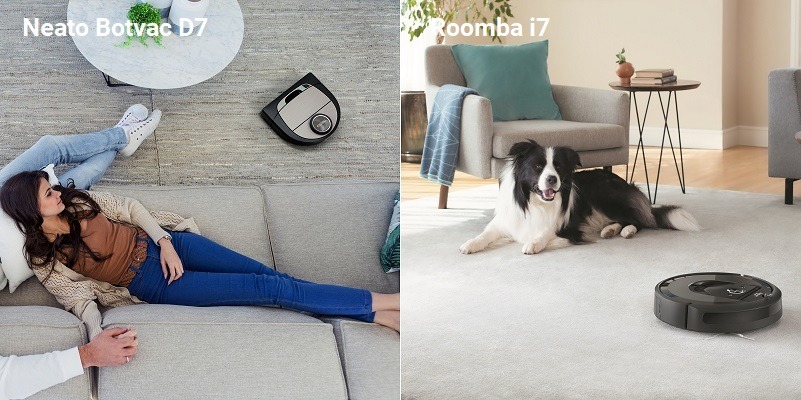
Late in 2018, Neato added a few small features that they didn’t talk much about. They quietly went to work on making the robot even better and just let the results speak for themselves. One of the additions was a firmware update that allows the robot to increase suction power on tougher carpets.
It is similar to the Roomba’s carpet boost feature, but not quite. When Roomba introduced the carpet boost feature they added sensors to automatically adjust the height of the extractors. The Neato D7 doesn’t adjust brush roller height, instead they just increased motor rotation. This in effect gives more power and creates greater suction, but at the cost of wearing down the battery faster.
That spilled flour? It will be more noticeably removed after a single pass with the Neato, but not all the way gone. The robot also doesn’t have the detection sensors to know if it got it all as the Roomba does.
If you only allow one pass, though, the Neato D7 will have a better clean. If you allow the machines to complete the cleaning cycle, the Roomba will stand out as the better cleaner overall. It’s up to you.
Hard Flooring is Almost Equal, Though the Roomba Gains a Slight Advantage
When it comes to hard flooring, your vinyl, tile, ceramic, marble and stone floorings will all be cleaned beautifully by either robot.
The big difference is the combination brush rolls and how they treat softer flooring. If you have soft wood, such as pine, or a floor like natural stone that requires a sealant, the Neato BotVac will most likely disappoint in the long run.
The bristles on the brush roll are stiff, designed to agitate deep into carpet fibers. Even with the rubber paddles alternating between the bristle sections, on softer flooring surfaces and sealants,this can cause scratches, marring and grooves.
The Roomba i7 uses the rubber extractors that don’t have bristles. iRobot calls them “dual brushless extractors,” which is just a fancy term for rubber brush rolls.
However, the numbs and grooves on the extractors will not mar surfaces or cause scratches. Not on sealant, softwoods or hardwood surfaces. If these are your types of floors, the Roomba is the better option.
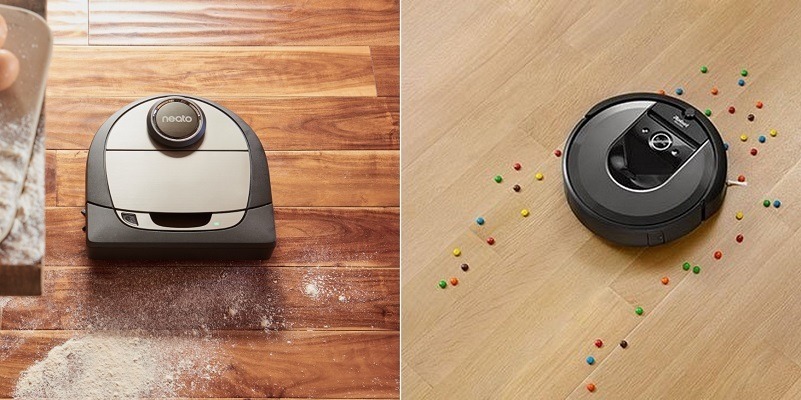
Bottom Line: The Roomba i7 wins. With the ability to still clean all floors and not leave marks behind, it is a simple win.
The Mobile Apps and Control Options are Among the Best for Both Models
When it comes to controlling your robots, you have plenty of options. Both the Roomba and the Neato offer limited local controls, but if you are inclined to bend over to push a physical button, the option to do so is still there.
Likewise, both units will connect through your wireless network and sync with Google Assistant and Amazon Alexa devices to allow for voice controls. Through these voice controls you can set up a schedule, cancel a cleaning session or start one. You can check out the iRobot or Neato websites to find the full list of abilities.
The majority of your control and programming time will be spent on mobile apps. The iRobot HOME app is considered one of the best in the industry. It is highly intuitive, easy to use and offers everything you could need to control, schedule and program your robot.
With the release of the i7, a new portion of the mobile app was added called Imprint Smart Mapping. Basically what this is is a map of your entire floor plan as it is seen by the robot. As it moves around your home, it identifies walls and rooms and puts the finished map on your phone.
Through this interactive map, you can name the rooms, which is then updated to the robot. What this means is that you can then tell the Roomba to clean only a specific room or rooms, by marking them on the map. You can also use voice controls with this feature as well, by saying things like “Alexa, tell Roomba to clean the kitchen.”
Neato Uses a Similar app Feature Called No-Go Lines
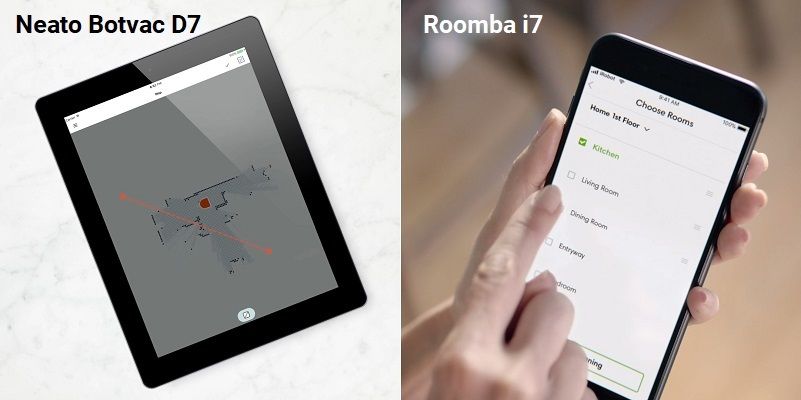
Neato has had a feature called No-Go Lines for a couple of years now and it has shown nothing but improvements since the initial release.
With this, you also get a map of the floor layout on your smartphone and you can draw lines on the map that the robot isn’t allowed to cross. It is a digital barrier if you will. Now, when this was first introduced, it was very buggy. Most of the robots would ignore the lines and clean on the other side of them anyway. Other issues were reported as well, such as the robot not cleaning a room at all if there was a single No-Go Line put anywhere inside it.
With the last update of the app, most of these reports have diminished. While there are still occasions of robots behaving badly, for the most part, it is now under control.
Aside from this feature, the Neato mobile app is still one of the best alongside the Roomba app. It isn’t as intuitive to start with, but has all the same features and uses. Once you get around the often cumbersome navigation, the app becomes much easier to use.
Bottom Line: The Roomba i7 wins. The app is more user-friendly and the Imprint Smart Mapping allows for digital barriers as well as voice control to clean specific areas.
Frequently Asked Questions
There are several questions that commonly come up when comparing these two models and I would like to take the opportunity to answer them for you here.
Q. What is the maintenance like for these two machines?
A. Maintenance is actually very simple for both models.You will need to perform regular maintenance and keep up on it. Otherwise, it can become a daunting chore. Each model has a specific recommended timeline for changing things such as filters, side brushes, etc.
The basic thing to keep in mind is that you need to keep the machines clean, the rollers free of debris and visually inspect the filters and brushes weekly. When the filters are too clogged to continue using, change them. When the brushes start to wear down, replace them.
The most difficult part will be keeping the brush roller on the Neato clean of hair and tangles. Because of the bristles, this can take some time. With the Roomba, it is much easier, though, you can wipe it off with your hands and put it back in within a matter of moments.
If you maintain a regular regimen, maintenance for either machine should only take about 20 minutes per week, less once you get the hang of it.
Q. How much will the collection bins hold?
A. Both bins are the same capacity, holding 0.7L worth of debris. Emptying them should be done after every cleaning cycle for the first few runs. They will collect a lot of dirt and debris until it gets to a more manageable routine.
After the third or fourth run through the home, you won’t have to empty as often. You can usually go two or even three cleanings with a bin that size. Just make sure you check it often and empty when needed.
One of the benefits of the Roomba i7 is the washable bin. It isn’t dishwasher safe, but it is waterproof. As long as you remove the filter first, you can rinse the bin out under warm running water and get all the dust an build up out.
The Roomba i7 can be upgraded to the Roomba i7+. The only difference here is the charging station and collection bin. The charging station comes with a tower that holds a vacuum bag and the collection bin has a suction port.
When the robot docks to recharge the battery, the tower suctions out the collection bin and stores it in the vacuum bag. You can usually hold 30 bins worth of dirt and debris before the bag needs to be changed.
You can read more about the i7+ in my article comparing the i7 to the i7+.
Q. Are there other forms of containment besides mobile apps?
A. There certainly are! Both the Roomba and Neato come with physical barriers that you can use in addition to, or instead of, the mobile apps.
For the Neato, you will get a roll of magnetic strip tape. This is cut and laid wherever you want the robot to avoid entering. It can be used across doorways, in certain areas of specific rooms or around valuable items and wobbly furniture.
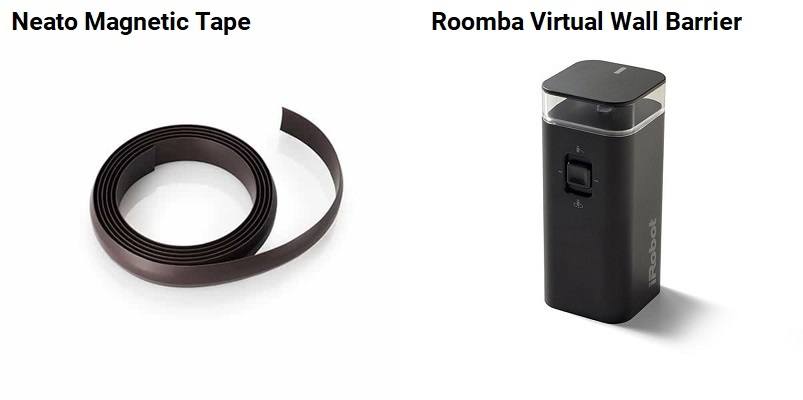
The Roomba uses a battery operated tower called a dual mode virtual wall barrier. You set these up in the same manner, in doorways, around objects or in certain areas of rooms. It has two modes (obviously) which either sends out a linear infrared beam (10-foot reach), or a circular infrared ring (four-foot diameter).
What I Like About the Roomba i7
- Extra long battery life for up to two full hours of cleaning.
- Mobile app controls and learning robot to make sure all floor space is covered.
- Up to 10 different floor plans can be stored and recalled with Imprint Smart Mapping.
- Can be upgraded to the i7+
What I Like About the Neato BotVac D7 Connected
- Huge improvements to the motor allow for better cleaning on carpeting.
- No-Go Lines improve containment without making a mess.
- HEPA filtration to reduce in-home allergens.
- Laser Smart vSLAM navigation is highly accurate.
In Conclusion
When it comes to maintaining the cleanliness of your floors, no robot vacuum will replace your standard upright. They just cannot produce the power and suction. However, with the Roomba i7 and the Neato D7, you can make less frequent trips to your closet for the old upright.
The Neato D7 quietly upgraded the firmware and software as well as the mobile app over the last 18 months. It is now a real rival for the crown as best in show. It will deep clean almost any carpet and hard flooring surface. However, caution still needs to be made when it comes to softer flooring and high pile carpeting.
On the other hand, the Roomba i7 has a systematically new cleaning style with an off-set motor that produces constant power and suction making it ideal for any floor surface. The Imprint Smart Mapping, HEPA quality filtration and dirt detection keep it ahead of the Neato D7.
